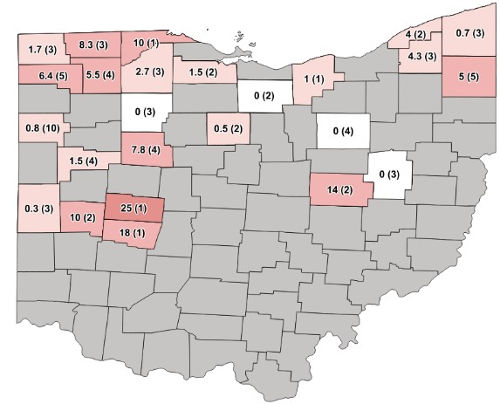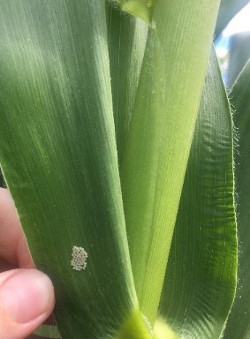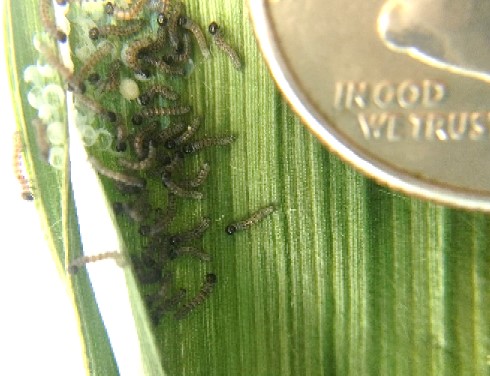By Amy Raudenbush, Kimberley Gault et.al.
Week three of The Ohio State University Western bean cutworm (WBC) monitoring network has resulted in an increase of moths captured. Last week’s trap count included WBC adults captured from July 8 – July 13. A total of 24 counties monitored 75 traps across Ohio. Overall, trap counts increased, resulting in a total of 287 WBC adults (18 total last week) and a statewide average of 3.8 moths/trap (up from 0.3 average last week) (Figure 1).
While it is not likely we are at peak flight for WBC in Ohio just yet, there are counties that reported a trap average that indicates scouting for egg masses should begin. These counties include: Champaign, Clark, Coshocton, Fulton, Hardin, Lucas and Miami.

Figure 1. Average Western bean cutworm adult per trap followed by total number of traps in the county in parentheses for week ending July 13th, 2019.
Scouting and management.
- Check pre-tassel corn approaching tassel fields first – females prefer these fields to deposit eggs.
- To scout for eggs or larvae, choose at least 20 consecutive plants in 5 random locations (scout different areas of the field that may be in different growth stages).
- Inspect the uppermost 3–4 leaves.
- Threshold (when to consider treatment):
- Field corn, if >8% of inspected plants have eggs or larvae.
- Sweet corn, if >4% of inspected plants have eggs or larvae for the processing market or on >1% of plants for fresh-market.
If infestations exceed threshold, many insecticides are available to adequately control WBC, especially those containing a pyrethroid. However, as with any ear-burrowing caterpillar pest, timing is critical. Insecticide applications must occur after egg hatch, or after tassel emergence, but before caterpillars enter the ear. If eggs have hatched, applications should be made after 95% of the field has tassel. If eggs have not hatched, monitor for the color change. Hatch will occur within 24–48 hours once eggs turn purple. To search for larval injury after it has occurred, search the corn for ears having feeding holes on the outside of the husks.
Life cycle and feeding. Adult moths (what we monitor in the traps) will be making their way into corn fields where females lay eggs on the uppermost portion of the flag leaf. Eggs are laid in unevenly distributed clusters of 5–200, but averaging about 50 per cluster, and hatch within 5–7 days (Figure 2). Eggs first appear white, then tan and then a dark purple. Once eggs turn purple, they will hatch within 24 to 48 hours (Figure 3). In pre-tassel corn, caterpillars will move to the whorl to feed on the flag leaf and unemerged tassel. Once the tassel emerges, larvae then move to the ear, while feeding on corn pollen, leaf tissue, and silks. Later they will enter the ear through the tip, or by chewing through the side of the husk. Damage occurs from both direct feeding and from mold problems at feeding sites.

Figure 2. WBC egg mass

Figure 3. WBC larvae hatching from egg mass. Size compared to US dime.
Source: osu.edu